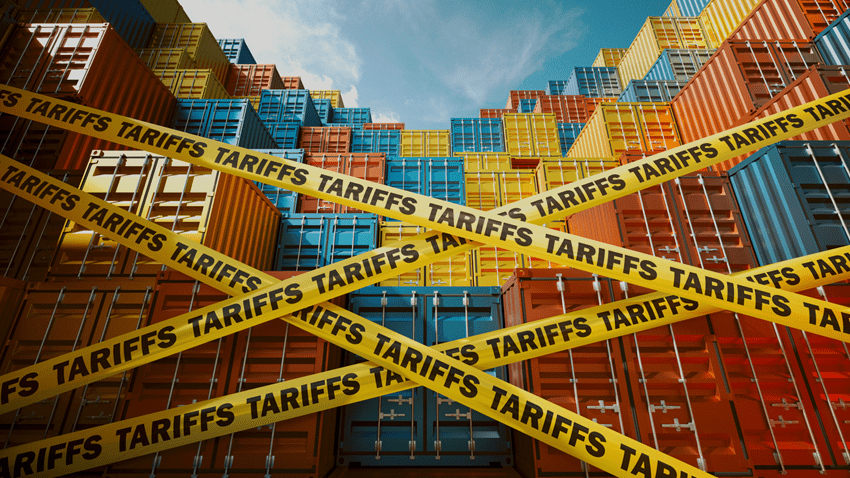
Summary
The rapid escalation of US tariffs is reshaping global trade dynamics, with countries and businesses adjusting to evolving trade agreements and negotiations. While widespread supply chain disruptions have not materialised, signs of localised congestion and suspected rerouting of trade are emerging.
Importers responded to anticipated tariff hikes by accelerating shipments to the US early in the year, causing a temporary surge in volumes across diverse product categories. This front-loading activity has complicated efforts to assess the isolated impact of tariffs on trade and other economic indicators, with large fluctuations observed in the GDP data, as well, in response to shifts in net trade.
Vietnam has seen a notable rise in trade with the US in recent years, which coincides with the escalation of tariffs on Chinese goods under President Trump’s first term. In many cases Chinese factories physically relocated production to Vietnam, but also the rerouting of goods made in China, via Vietnam, is still suspected. With Vietnam under the watch of US customs officials, this trend now appears to be broadening to include Thailand and Malaysia, as both the US and China have increased trade with these nations in recent months.
Despite a sharp decline in direct US-China trade, China has maintained strong export performance by redirecting goods to other global markets, in a combination of rerouting and finding new sources of end-consumers.
For Australia, the effects of trade redirection have been minimal, with exchange rate movements playing a more significant role in shaping import costs.
Trade developments
The full implementation of the country-specific ‘reciprocal’ tariffs announced in April would have driven the US effective tariff rate from around 2.5% to nearly 20%; a level not seen in modern US trade history. The effective tariff rate reflects the average tariff burden faced by importers. It accounts for the composition of imported goods, the volume of trade, and the presence of exemptions or preferential trade agreements.
While subsequent negotiations, legal challenges, and temporary pauses have moderated the scale of the increase, the impact remains significant. As of the second quarter 2025, the effective tariff rate had already climbed to over 8%, marking its highest level since the 1970s. This upward trend could be expected to continue in the coming quarters as bilateral agreements expire or stabilise, and as retaliatory measures and supply chain adjustments take fuller effect.
At this stage, there has been limited evidence widespread supply chain disruptions, with the global supply chain pressure index around average levels. However, aggregate data will mask congestion or disruptions at individual ports. This series is rarely above its average (COVID-19 years aside) so even a modest increase may highlight a tightening of supply chains.
Many importers accelerated shipments to the US earlier in the year to build up inventories before higher duties took effect, leading to a temporary surge in import volumes.
Meanwhile, US exports have shown modest growth, in part driven by foreign buyers seeking to showcase improved trade positions with the US, secure supply chains and hedge against future disruptions (especially in sectors vulnerable to retaliatory tariffs). Exports of liquefied natural gas (LNG), aircraft parts, and high-tech goods, such as semiconductors and medical devices, have seen strong demand.
The stockpiling of imported goods was evident across a wide range of product categories. This included capital goods (industrial machinery and medical equipment), consumer electronics (laptops, smartphones, household appliances) and semiconductors. Automobiles and auto parts, pharmaceuticals and consumer goods also saw a spike of import activity.
A notable surge occurred in the precious metals market, where traders rushed to move bullion into the US amid tariff-related uncertainty and strategic repositioning. This led to a sharp increase in gold inflows, especially from Switzerland and Australia, as market participants sought to hedge against potential disruptions.
Front-loading of imports was particularly pronounced in shipments from China, Canada, and Europe, with the unwind most stark in China and Canada. Meanwhile, US imports from Vietnam and other Southeast Asian nations have increased, suggesting potential rerouting of Chinese exports through third countries.
The US administration has sought to curb rerouting practices, a predictable consequence of nonuniform tariff structures across trading partners. Customs and Border Protection (CBP) enforces strict country-of-origin rules, requiring that goods undergo substantial transformation in a third country to qualify as non-Chinese origin.
US authorities have warned Vietnam exporters that higher tariff rates will apply if goods are found to be redirected from China without meaningful modification. Vietnam emerged as a beneficiary of the US-China trade tensions that escalated during Trump’s first term. Following the initial round of tariffs on China in mid-2018, Vietnam’s exports to the US surged by 35% in 2019, reflecting its growing role as a key alternative sourcing hub.
Chinese manufacturers have relocated factories and operations to Vietnam, primarily to capitalise on lower labour costs. Key industries benefiting from this shift include textiles, garments, and plastics. While this relocation trend was already underway due to rising costs in China, the imposition of US tariffs likely accelerated existing plans. This activity now appears to be broadening to other Southeast Asian countries.
Chinese export volumes typically dip in the early months of the year due to seasonal disruptions around the Lunar New Year, when factories shut down and logistics slow. Trade activity rebounded in the months that followed, showing no clear signs of a tariff-induced slowdown. In fact, exports in July were 7.2% higher than a year earlier.
Indeed, China has been able to redirect lost trade with the US towards Europe, Asia and Latin America, capitalising on strong demand for electric vehicles, green technologies (such as solar panels and batteries) and consumer electronics.
Comparing the rise in China’s exports towards Southeast Asian countries with US imports from the same nations suggests rerouting activity is occurring and that US imports from these countries will continue to grow in the coming months unless the customs bureau is able to crackdown on this activity.
For Australia, the impact of trade redirection has been limited. The Reserve Bank of Australia noted some firms have reported isolated instances of discounted imported goods due to changing trade flows. This is unlikely to become widespread while China is able to maintain exports volumes. The Reserve Bank of Australia stated importers have said that movements in the exchange rate are a more important factor in cost determinants, which has driven overall import values higher in recent years. Separately, exports have fallen over this time as China’s demand for iron ore and coal has slowed.

